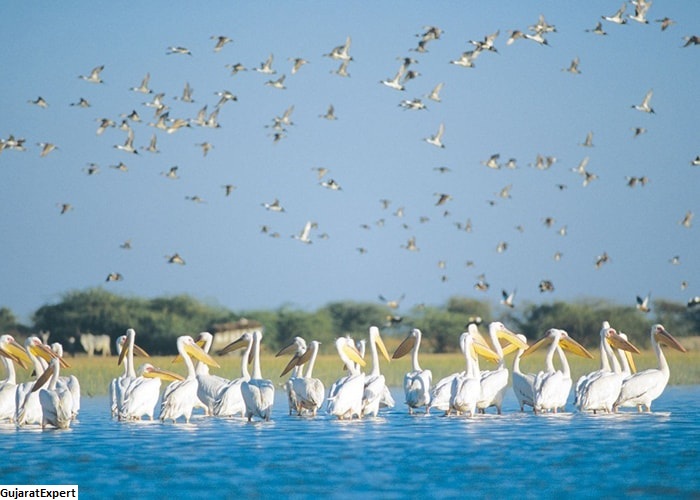
Talk to most people in Gujarat about Narayan Sarovar and they will talk about Koteshwar and pilgrimage to this place. Narayan Sarovar or Narayan Lake that is big enough to be home to a variety of birds and aquatic life. It was far bigger during ancient times until the Indus River changed course. Narayan Sarovar surroundings are a sanctuary and a pilgrimage spot, two good enough reasons to visit this place.
History
The Narayan Sarovar Wildlife Sanctuary takes its name from the village and lake of the same name located in Lakhpat in Kutch in the northwest of Gujarat in western India. Lakhpat is a deserted fort that was, at one time, a flourishing settlement. The sanctuary came into being in 1981 but was surprisingly denotified in 1995 with the area reduced in order to allow commercial mining of lignite and limestone as well as other minerals. In its present form, the sanctuary is made up of several separate stretches of land totaling 94.8 sq. km from its original area of 765 sq. km. Litigation followed and the sanctuary size was fixed at 444 sq. km. It is mainly desert forest area with some parts becoming waterlogged during monsoons. It is home to a unique mix of vegetation and wildlife but open quarry limestone and lignite mining have contributed to the reduction in wildlife, especially chinkaras. Even humans are affected as the groundwater has turned salty and they are leaving the area.
The sanctuary in its present form has the Kori Creek to the northwest. The northwest is flatland leading to the sea. The eastern side has some hillocks with Manijal and Kaniyaro Rakhal hills in the northeastern side. You are seasonal streams Kapurasi and Kali besides 15 reservoirs around the sanctuary.
Flora
The vegetation here is mostly scrub forest but still, it has some rare plants and grasslands. The salinity of groundwater stunted tree growth further exacerbated by winds and rocky soil. Only tough and hardy trees like acacia, euphorbia cactus, gored and similar trees grow in this area. The sanctuary is home to about 252 species of plants and trees that include informal kendo, cariso and Ogando bevel besides medicinal gugal trees.
Fauna
One would think a dry and inhospitable region like the Narayan Sarovar would be bereft of wildlife but it is not so. There is an abundance of fauna including the famed great Indian Bustard, the lesser floricans, black partridge, francolin, dove, robins, bulbul, larks and munias and raptors besides migratory birds in winter. Chinkaras, however, is the attraction but their number is reducing. One can also find caracals belonging to the feline family, wolves, pangolin, foxes, and cheetahs.
Getting There
Driving in one’s own car or a hired car is a good way to get to the Narayan Sarovar Chinkara Sanctuary. One can start from Bhuj, about 115 km away or a long journey from Ahmedabad, about 515 km away. Some might find it convenient to travel by bus to Dayapar and then take local vehicles, or reach Bhuj by train and travel by road to the Lake and explore the sanctuary.
Good Time to Visit
The monsoons end around September, which is perhaps the best time to visit because there is still some greenery and water bodies around and the climate is pleasant though it can be a bit hot out in the open. December onwards to March is good enough for most tourists but it can be cold at night. The Rann Utsav is held in Kutch in winters and it may be a good time to take in the Chinkara sanctuary along with others in the vicinity besides enjoying local Kutchchi food and buy Kutchchi handicrafts.
Places Worth a Visit
Koteshwar is an ancient Shiv temple, a jyotirlinga site and the reason most people visit Narayan Sarovar but the place itself is home to an ancient temple dedicated to Lord Vishnu. It is believed the Lord visited this place, created the Lake and made it his home. The lake is considered just as scared as Mansarovar and it is one of the Panch Sarovar for pilgrimages in India. Drive about 4 km and you will come upon the Koteshwar temple dedicated to Lord Shiva, standing next to a marsh. Mythology states that Ravana was granted a boon by Shiva and received a magical lingam that bestows immortality provided it was not dropped on the way to Lanka. However, Ravana was fooled into leaving the lingam at Koteshwar and it dispersed into tiny pieces.
Stay
You can find a Dharamshala at Narayan Sarovar for stay and spend the days in exploration. Alternative accommodations are at Matanomadh and Panandhr.
Indiscriminate exploitation of ground resources and lack of political will in conservation measures may mean that wildlife will dwindle. Make the best of the present and visit the sanctuary while there is something still left to see and experience.
List of wildlife sanctuaries of Gujarat
- Gaga Wildlife Sanctuary
- Jambughoda Wildlife Sanctuary
- Thol Wildlife Sanctuary
- Rampara Wildlife Sanctuary
- Pania Wildlife Sanctuary
- Hingolgadh Wildlife Sanctuary
- Khijadiya Wildlife Sanctuary
- Kutch Wildlife Sanctuary
- Nal Sarovar Bird Sanctuary
- Ratanmahal Sloth Bear Sanctuary
- Jessore Sloth Bear Sanctuary
- Purna Wildlife Sanctuary
- Barda Hills Wildlife Sanctuary
- Narayan Wildlife Sanctuary
- Balaram Ambaji Wildlife Sanctuary
- Shoolpaneshwar Wildlife Sanctuary
- Gir Wildlife Sanctuary
- Wild Ass Sanctuary
- Marina National Park
- Vansda National Park
- Blackbuck National Park
- Gir Forest National Park
- Flora Fauna Gir National Park
- Devaliya National Park


Leave a Reply